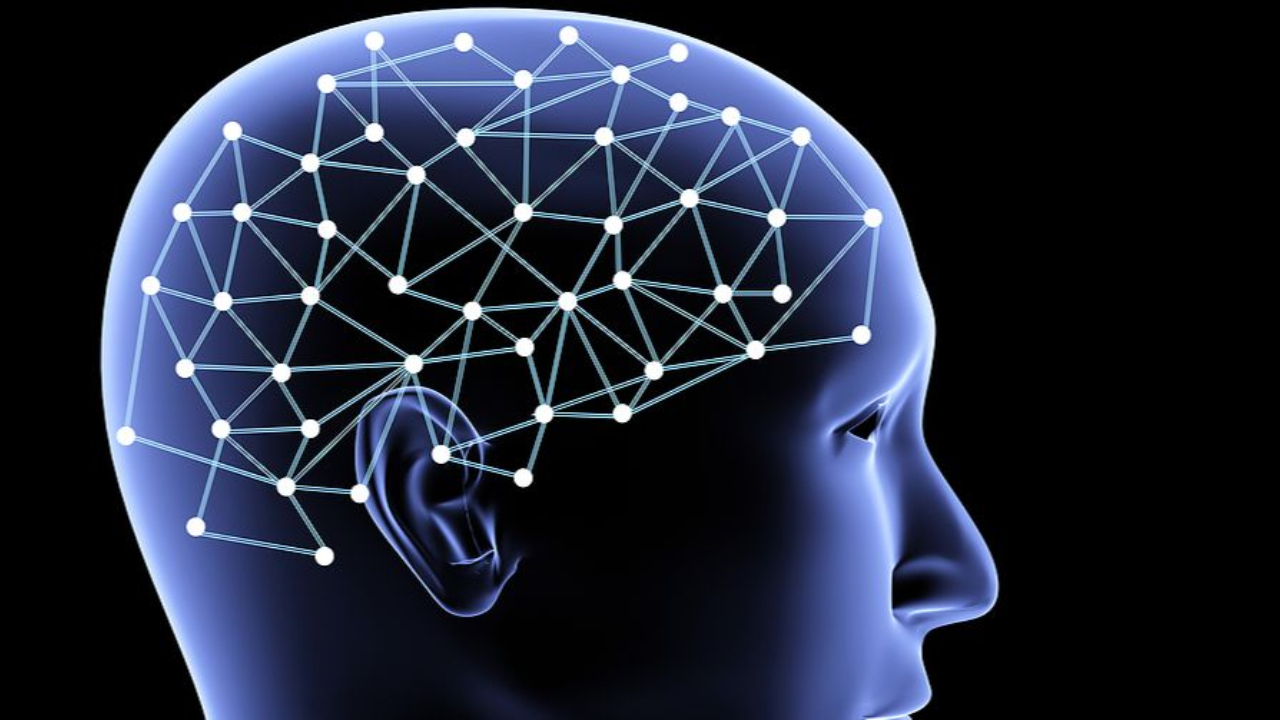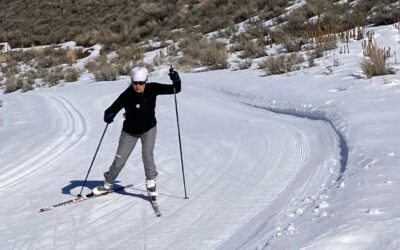Pain Reprocessing Therapy (PRT) is a research-based treatment approach for healing neuroplastic pain. These techniques were found to be highly effective for chronic back pain in a 2022 study. Refer to my blog, New Research on Back Pain, for all the details. Earlier this month, I completed a certification course in PRT. In this blog, I’ll be sharing some of what was taught. I’ll start by explaining how pain is learned.
Pain and physical skills are developed through an identical process: repetition of the same pattern over and over and over again. This is true whether you are learning how to corner on skinny Nordic skis, weaving yarn, playing a guitar chord, welding metal, or creating pain. These patterns become wired into the brain. Although physical skill acquisition is often referred to as “muscle memory,” it is not actually the muscles that are learning. Instead, it’s the brain that is establishing and refining specific neural patterns.
Let me explain. As you practice your volleyball serve or experience pain while moving or being stationary, your brain is learning and developing neural networks, called neurotags. These neurotags are permanent. Hence, the saying, “It’s just like riding a bike.” Once you learn how to ride a bike, your brain always remembers, even if your body is a bit shaky.
To be clear, this is true for neuroplastic pain, which does not have a structural cause. Rather, neuroplastic pain is due to misfiring of these pain neurotags. Basically, your brain inappropriately triggers the pain sensation. The brain makes a mistake because it (incorrectly) assesses safe physical sensations, such as normal muscle tension, as being dangerous. Unfortunately, neuroplastic pain is extremely common. A recent study found that 88% of chronic back and neck pain are neuroplastic. I agree, and I have actually experienced this in my own body.
 Pain Neurotags
Pain Neurotags
Let’s delve a little deeper. A pain neurotag consists of several neurons/brain cells (shown as stars in the image) that are distributed throughout the brain. These neurons are all interconnected. Any of these brain areas can trigger the sensation of pain. You can think of the stars as pain generating sites. Take a moment now to notice how many stars there are in the image and, consequently, how many different starting points there are to create pain.
For instance, pain can be the output of the prefrontal cortex area of the brain, located in the very front of the brain (front stars). In this case, a mere thought or perception could trigger pain. Likewise, the amygdala area of the brain (one of the stars near the center) can also initiate a pain response. The amygdala is the fear and addiction area of the brain. Thus, fear can also trigger pain. Keep that in mind as you read on.
Neuroplastic Pain is Learned Quickly
We learn pain faster than other skills. Instead of taking the often quoted 10,000 hours to develop a new skill, pain is learned in only months. Why?
Consider that you’re learning a dink shot in pickleball. Every time you practice this shot, especially in the beginning, you have a different result. Sometimes you successfully put the ball exactly where you planned; sometimes the ball lands outside the court line; and sometimes the ball goes straight into the net. While learning this skill and developing your dink shot neurotag, there is a lot of variety in the execution. Because there’s so much disparity, it takes the brain a long time to wire in or to create an effective neurotag for the dink shot. However, this is not true for pain neurotags.
The pattern to create pain is consistent every time. You feel the sensation of pain the same way with little to no variation each time. Pain neurotags fire rapidly. Dr. Hanscom compares it to a machine gun in his book, Back in Control. Thus, our brain frequently triggers and repeats this consistent pain pattern, essentially “practicing pain” over and over again, exactly the same way. Let’s think back to the pickleball example: let’s say you practice your dink shot for one hour a day. Compare this to “practicing” pain for 14 hours a day. Clearly, pain is going to be learned much faster.
Reduce Fear to Unlearn Pain
Yahoo! Here’s the good news: our brains are neuroplastic and can change. Just as pain is learned, it can also be unlearned. Ok, you might be saying, aren’t those pain neurotags permanent? Well, yes, they are. (Thanks for paying close attention and bringing that up.) However, a neurotag has no power without activation. You can have a pattern for pain in your brain without triggering it. A neurotag that doesn’t fire doesn’t cause pain.
Now recall that bit about fear I asked you to keep in mind. Fear can activate a pain neurotag. Recall the star–the pain generating site–in the amygdala that can initiate pain when activated. Conversely, not being scared does not trigger the pain neurotag. Hence, fear fuels the pain. Explore the Pain-Fear Cycle that I discussed in a previous blog. In the PRT course I completed, they taught us a simple equation:
Pain = Sensation + Fear
 The goal of PRT is to reduce and ultimately eliminate the fear so that the pain neurotag is not activated. This involves reinterpreting bodily sensations as safe. These physical sensations in the body must be separated from the often-automatic emotional response of fear. In a broad sense, fear includes any negative emotion that increases our sense of danger, such as frustration, anxiety, disappointment, stress, etc. Fear puts the body into a state of fight or flight, which activates the sympathetic nervous system, or SNS. When fear is removed, the equation becomes this:
The goal of PRT is to reduce and ultimately eliminate the fear so that the pain neurotag is not activated. This involves reinterpreting bodily sensations as safe. These physical sensations in the body must be separated from the often-automatic emotional response of fear. In a broad sense, fear includes any negative emotion that increases our sense of danger, such as frustration, anxiety, disappointment, stress, etc. Fear puts the body into a state of fight or flight, which activates the sympathetic nervous system, or SNS. When fear is removed, the equation becomes this:
Pain = Sensation
Now, pain is merely a sensation that is open for reinterpretation.
Turn Down the Intensity on the SNS
However, PRT has a bigger objective than just reducing fear. PRT strives to help clients lower their overall stress so they don’t stay stuck in the SNS. Recall that pain follows an emergent pattern and has many contributing factors that raise our stress level. Also remember that living in a high alert state can feel normal, as I discuss in this blog: Why Stress Feels Good and Relaxation is Hard. Reducing neuroplastic pain, then, requires calming our stress response. This can be a challenge, as research demonstrates.
A surprising study mentioned in the PRT training course was done at the University of Virginia. Check this out: researchers brought people into the lab, put them in a room by themselves, and told them to essentially sit and do nothing for 15 minutes. Sounds nice, right? Well, the participants didn’t think so. The majority rated the experience as “difficult” and “unpleasant.” In fact, 32% of the people cheated by taking out their phones.
Later, the same people revisited the lab. During this second visit, the researchers added a twist: this time, they hooked the people up to a machine that delivered an electric shock. Researchers had people hit the control to administer the shock, and it hurt. The participants were given the control to administer the shock but were not given any instruction to do so. Then, they were told to sit in stillness for 15 minutes. Ok, here’s the crazy part: 43% of the people shocked themselves. One person administered 190 shocks! What is going on?
For many of us, being stressed out is familiar. You could say it is our comfort zone. We feel safe when our nervous system is frazzled. People administered shocks to themselves in an attempt to re-establish a high state of alert, to activate the SNS. They were uncomfortable with the unfamiliar and, in this case, a shock was preferable to the foreign feeling of being calm and relaxed without stimulation.
Stimulation, particularly overstimulation, keeps us in the SNS and can become addictive. As mentioned earlier, the amygdala area of the brain is the fear and addiction center. Something to ponder: Am I addicted to stimulation? Can I sit quietly for 15 minutes, or would I be like the people in the study who found a way to stress themselves out to avoid being still?
For many people, PRT treatment includes re-setting their comfort zone to a lower state of alert. Reducing overstimulation was one of the techniques used in PRT to achieve this. Tune in next month to learn more.
____________________________________________________________________________
Hanscomb, D. (2017). Back in Control: A surgeon’s roadmap out of chronic pain. Vertus Press.
Louw, A. (2018). Pain Neuroscience Education: Teaching People About Pain. Orthopedic Physical Therapy Products.
Pain Reprocessing Therapy Center Course
Schubiner H, Lowry WJ, Heule M, Ashar YK, Lim M, Mekaru S, Kitts T, Lumley MA. Application of a Clinical Approach to Diagnosing Primary Pain: Prevalence and Correlates of Primary Back and Neck Pain in a Community Physiatry Clinic. J Pain. 2024 Mar;25(3):672-681. doi: 10.1016/j.jpain.2023.09.019. Epub 2023 Sep 28. PMID: 37777033.
Stay connected with news and updates!
Join our mailing list to receive the latest news and updates from me.
Don’t worry, your information will not be shared.
We hate SPAM. We will never sell your information, for any reason.



